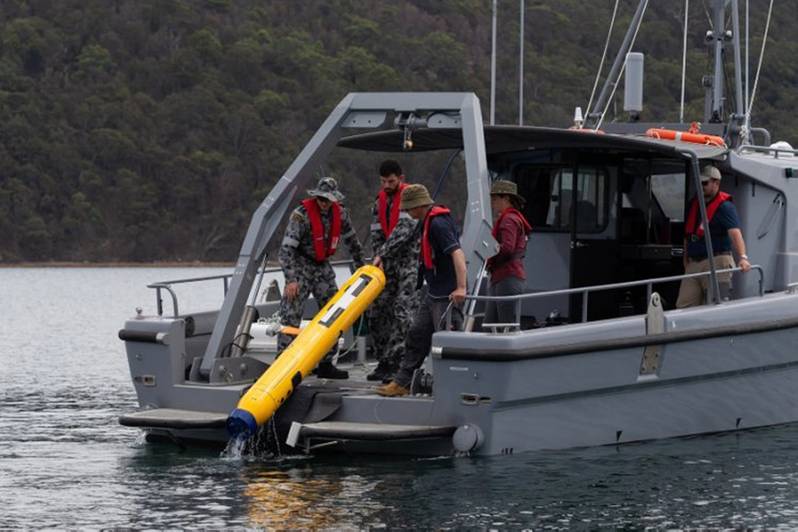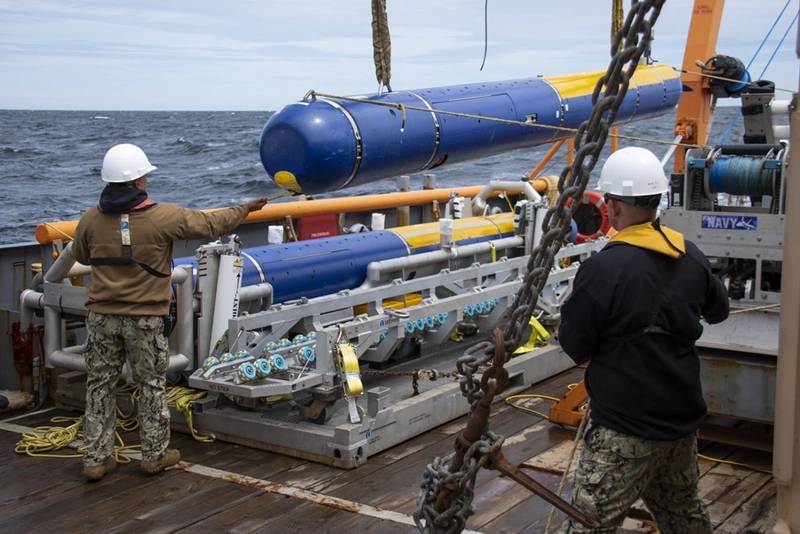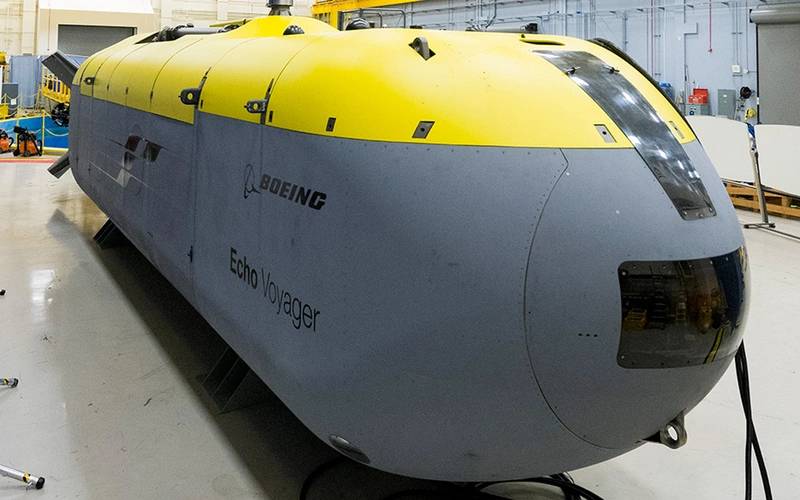Subsea Defense: Navy Deepens Commitment to Underwater Vehicles
The U.S. Navy uses unmanned and robotic underwater vehicles for a multitude of functions, including environmental sensing, mine hunting, and salvage. The Navy plans to evolve an unmanned systems operating concept that is platform agnostic and capable of operating in highly complex contested environments with minimal operator interaction.
The most recent edition of the Navy’s Unmanned Systems (UxS) Roadmap was issued in 2018, and a new version is expected in the near future.
The 2018 document states that UxS will operate in every domain; always be an option; and be at their best when teamed with Sailors and Marines
“UxS will strengthen naval power at, on, and from the sea by reducing operational risk and cost. UxS operating in the air, on the surface, under the sea, and on shore as a rapidly adaptable and interconnected network will provide access to areas denied to manned platforms, provide better situational awareness, increase capabilities with greater range and persistence, and enable faster decision making,” the roadmap stated.
The document allowed as how there continue to be barriers, including policy, doctrine, force structure, acquisition, and technology development. Perhaps most of all, the Navy and Marine Corps must continue to work to build operator trust and confidence in unmanned systems in all domains.
The tri-service maritime strategy, Advantage at sea, issued jointly by the Navy, Marine Corps and Coast Guard and released in December 2020, calls for greater numbers of distributable capabilities over fewer exquisite platforms.
“We will design our future naval force to support distributed operating concepts that rely on lower signature, highly maneuverable forces. Naval forces will mix larger platforms with standoff capabilities and smaller, more-affordable platforms—including optionally manned or unmanned assets—that increase our offensive lethality and speed of maneuver,” the document said. That includes unmanned systems.
According to the maritime strategy, as more Sailors and Marines use UxS, the importance of “the ability for them to act together coherently, effectively, and efficiently to achieve tactical, operational, and strategic objectives.”

Size matters
The Navy classifies its UUVs in four size categories: extra-large, large, medium, and small. All but the largest are deployed from a host platform.
The smaller categories can be delivered to the operating area and placed in the water by hand or from a boat, ship, helicopter or submarine to support a team afloat or ashore with environmental information or possible target location. Missions are measured in hours. The XLUUV category is usually deployed for a pier from where it can then transit to the operating area, and may augment some of the capabilities now performed by a manned platform. Missions are measured in weeks or months.
“Only XLUUV is explicitly intended for pier deployment only. LDUUV is the largest UUV planned for host submarine integration from large ocean interfaces. While LDUUV could be pier deployed, that is not the default concept of operations,” said Capt. Pete Small, PMS 406 (Unmanned Maritime Systems), with PEO Unmanned and Small Combatants . “The Navy is cautious to not imply that unmanned vehicles will replace manned submarines. They may take on missions done by manned platforms today, but are intended to augment, not replace, manned platforms.”
Small
The Navy uses small UUVs, which are man-portable or launched from a ship, helicopter or submarine, for battlespace awareness and underwater reconnaissance, such as the HII Hydroid Mk18 Mod 1 Swordfish or the L3 Harris Iver.
The Navy is currently partnered with the Defense Innovation Unit (DIU) for the Next Generation Small-Class UUV (SUUV) program to replace the MK18 Mod 1. In 2019, DIU awarded prototype Other Transaction Agreements (OTAs) to both L3Harris for its Iver4 and HII Hydroid for its REMUS 300 to modify these commercial systems to meet the Navy’s SUUV requirements.
Medium
Medium Unmanned Underwater Vehicles (MUUVs) are capable of persistent, autonomous, ocean sensing and data collection to support the Intelligence Preparation of the Operational Environment (IPOE) mission. They can be launched from a surface ship or submarine.
In the medium category, the HII Hydroid MK 18 Mod 2 Kingfish is currently used by Naval Expeditionary Combat Command (NECC) forces for mine detection, localization, classification and identification, as well as environmental sensing. It is generally launched from a rigid-hull inflatable boat (RHIB) by a team of Navy expeditionary Sailors using a small handling system. The vehicle is recovered after a mission and the data is downloaded and sent ashore for analysis.
Huntington Ingalls Hydroid is building the Razorback AN/WSQ-43(V) 2 Littoral Battlespace Sensing Autonomous Undersea Vehicle (LBS-AUV), which is launched from submarines to gather environmental information.
The Navy released an RFP in April 2020 for a new MUUV system to provide surface-launched mine hunting capabilities or torpedo tube-launched battlespace-sensing capabilities, depending on the configuration.
“The MUUV will be a modular, open systems, and open architecture UUV. In the Razorback Torpedo Tube Launch & Recovery (TTL&R) configuration, it will provide submarine-based autonomous oceanographic sensing and data collection in support of intelligence preparation of the operational environment. In the Maritime Expeditionary MCM UUV (MEMUUV) system configuration, it will provide persistent surface-launched and -recovered mine countermeasures (MCM),” the Navy said. “The notional MUUV will contain a common baseline vehicle architecture, including sensors and components, for the submarine and expeditionary configurations. Launch-and-recovery systems will reflect each configuration’s unique requirements and missions.”
The Navy would field the MCM variant first – supporting the expeditionary mine countermeasures teams who currently operate the Kingfish. The follow-on deliveries will support the submarine community’s version.
The Knifefish UUV has a low-frequency broad band sonar to conduct volume, bottom, and buried minehunting capability for the LCS mine countermeasures (MCM) mission package (MP), and can also be deployed from and vessels of opportunity (VOO). Knifefish is built upon the General Dynamics Mission Systems Bluefin 21 vehicle.
According to Dr. Sam Taylor, PEO Unmanned and Small Combatants Senior Leader for Mine Warfare, Low frequency broadband (LFBB) is a description of the acoustic energy employed by the sonar to enable it to sense objects that might go undetected by other sonars. LFBB on Knifefish is used to find buried, bottom, and volume targets in highly cluttered environments. Knifefish is the only system used for buried minehunting.
“Knifefish is being built in blocks to incorporate new technology to increase performance in each block. Knifefish is part of the LCS mine countermeasures (MCM) mission package ( MP) and is also being built so that it can be employed from other vessels of opportunity,” said Taylor.
The development of Knifefish, both its sensing and processing, was a result of a successful collaboration within the Naval Research and Development Establishment (NRDE). “The NRDE spent years developing prototype sensors and algorithms that were tested in relevant environments to perfect the technology for transition to a program of record,” Taylor said.
“Low-frequency broadband (LFBB) is our term for a technology area that we developed here at the Naval Research Laboratory (NRL) that exploits the structural acoustics involved with underwater sonar,” said Dr. Brian Houston, Acoustics Division superintendent at NRL. “When you transmit sound, the acoustic return is very different depending on the physical object that is reflecting that acoustic energy. It might be a naturally occurring thing like a rock on the bottom, or something that’s man-made, like a mine. In the water column, it might be a submarine versus a whale. What’s in the acoustic return is very different for each of those targets. Sonar has traditionally helped us know where something is, how far a way it is, and sometimes provides an image. But in addition to bearing and range, we can now determine what it is.”
Large
The Navy is evaluating two different Large Displacement Unmanned Underwater Vehicle (LDUUV) concepts.
An Innovative Naval Prototype LDUUV has been built by the Office of Naval Research. ONR’s INP is being used to evaluate software, autonomy, command and control, and integration of various payloads.
Naval Undersea Warfare Center-Newport is the lead integrator for the Snakehead LDUUV, which will be used to conduct intelligence and preparation of the environment (IPOE), and intelligence, surveillance and reconnaissance (ISR) missions. The follow-on phase will look to give the system greater range. Potentially, additional payloads might include electronic warfare, mine warfare, mine countermeasures, anti-submarine warfare and anti-surface warfare.
The Navy released a request for proposals (RFP) on Dec. 23 for the design, development, and fabrication of Snakehead.
“With this solicitation, the government plans to competitively award a contract to a single vendor for fabrication of two prototype vehicles in fiscal year (FY) 2021,” the RFP said. “Snakehead is a long-endurance, multi-mission UUV, deployed from submarine large open interfaces, with the capability to deploy reconfigurable payloads. It is the largest UUV intended for hosting and deployment from submarines, and has been designated a Maritime Accelerated Acquisition. The LDUUV will achieve full integration with Modernized Dry Deck Shelter and Payload Handling System-equipped submarines. Initial vehicles will be designed to support Intelligence Preparation of the Operating Environment (IPOE) missions. Future vehicle missions may include deployment of various payloads.”
Extra Large
Orca is an autonomous extra-large unmanned undersea vehicle (XLUUV) for long-range undersea operational awareness and payload delivery.
The modular, open architecture UUV has a sizeable and flexible payload section. It launched from a pier and has very long range. Orca can be used for a variety of warfare missions or provide logistics support. It can reach a destination and sit on the bottom to await instructions or conduct a mission on a schedule.
In 2017 the US Navy selected Boeing and Lockheed Martin for design contracts in the first phase of the XLUUV program. Later, the Navy awarded a contract to Boeing for the first four Orca XLUUVs in February 2019, and subsequently expanded the buy to five. The total contract price for five vehicles is $274M. The Navy plans to start buying two per year starting in 2023, according to a Congressional Research Service report from March 2020.
Boeing’s Orca design is based on its Echo Voyager autonomous XLUUV. The 51-foot (expandable to 88 feet with the payload section) Echo Voyager has a range of 6,500 nautical miles and can perform several combat missions, including anti-submarine and anti-surface warfare.
Orca is launched and recovered at a safe port away from the area of operations and transit to the area where it will be working autonomously. It will be able to carry smaller UUVs as part of its payload. Assigning XLUUV to dangers or dull missions could allow a $3 billion Virginia-class attack submarine to be used for something more important.
One study conducted during Defense Secretary Mark Esper’s tenure by the Cost Assessment and Program Evaluation office called for a force of as many as 50 XLUUVs.
Salvage
The Navy employs several different subsea systems for subsea salvage work, including tethered robotic systems and UUVs. They can be used from a variety of platforms, and are employed under the direction of the Navy’s Supervisor of Salvage (SUPSALV).
The 6,400-pound CURV-21 ROV, built by Phoenix International, is the latest version in the series of CURV vehicles used by the Navy, can conduct salvage operations at depths up to 20,000 feet of seawater. It has more capability than CURV-III, its predecessor, but with a smaller overall system footprint.
DEEP DRONE 8000 is a 4,100-pound ROV has maximum depth of 8,000 feet and is equipped with manipulator arms and cutting tools. Different tools can be installed depending on the mission.
HYDROS is a 2,000-pound Remotely Operated Vehicle (ROV) that is designed to meet the Navy’s shallow water, light weight, rapid deployable salvage requirements to a maximum depth of 5,000 feet anywhere in the world. It has pinger-detection, sonar, cameras, manipulator arms and a lifting capability and can be deployed from vessels of opportunity.
SUPSALV’s Kongsberg Hugin 6000 AUV --called Trondheim--is equipped with a multibeam and synthetic aperture sonar, and is used for sonar searches, multibeam mapping, sub-bottom profiling, magnetic sensing, and high resolution still camera observation. The 23-foot AUV can operate in autonomous, supervised and trajectory modes. It has an endurance of 50-hours-plus and can dive to 20,000 feet. It can be deployed by any vessel of opportunity.
Gliders
The Naval Oceanography Enterprise provides warfighters with unique oceanographic products for operational and tactical decision making, and has been using underwater vehicles, including underwater buoyancy gliders, for many years. Gliders can be deployed from shore-based facilities as well as ships of opportunity, and operate in varying water depths down to 6,000 feet. Underwater gliders “fly” in the ocean by changing buoyancy to alternately sink or rise to the surface. Using wings that create lift, and a rudder, the glider can move slowly along an assigned course.
The Navy’s Littoral Battlespace Sensing-Glider (LBS-G) Program began as a program of record a decade ago with a contract for 150 gliders. The LBS-G gliders were manufactured by Teledyne Webb Research, with Teledyne Brown Engineering providing system integration and the University of Washington - Applied Physics Lab providing the Glider Operations Center software.
Gliders are able to collect data in a particular area of interest to the Navy for months at a time to help refine the ocean models that support operations in those regions Temperature and salinity affect water density, which directly impacts a submarine’s buoyancy, or how sound travels underwater, or how storms form and intensify.
Today, a third of those gliders are deployed operationally around the world at any given time, controlled by pilots at the Naval Oceanographic Office (NAVO) Glider Operations Center located at Stennis Space Center, Mississippi. The pilots communicate with the glider with Iridium satellite links to collect oceanographic data such as water temperature, salinity, water clarity and depth, and provide positioning and course instructions.
Gliders can operate in remote locations for extended missions to collect data, or deployed in conjunction with major fleet exercises to give participants near-real-time data that provides accurate weather and ocean condition forecasts.
The National Oceanic and Atmospheric Administration uses gliders to monitor marine mammals and fish stocks, and collect data to better understand the dynamic air-sea interaction processes during tropical cyclones, and thus predict storm formation, track and intensity.
NOAA employs 21 gliders, including Slocum G3 oceanographic gliders, Kongsberg Seagliders and Oculus gliders, used for fisheries research, storm intensity measurement and atmospheric and oceanic data collection. The vast majority of the NOAA-associated gliders are owned or operated by the IOOS regional associations (a partnership of 17 federal agencies and 11 regions, comprised largely of academia, as well as industry partners) or the Navy, so their data is at times compiled, given a quality control check, and made available to the public and operational forecast models via the US IOOS Glider Data Assembly Center.
Liberdade class are autonomous underwater gliders developed by the Marine Physical Lab at Scripps Institution of Oceanography, and the Applied Physics Lab at the University of Washington for the US Navy Office of Naval Research, that can fly underwater for up to six months. They were developed as part of the US Navy's Persistent Littoral Undersea Surveillance Network (PlusNet) system of unmanned surveillance vehicles. Their blended wing bodies help achieve hydrodynamic efficiency. The Liberdade gliders are the largest known underwater gliders.
Gliders are extremely quiet, and come up to the surface and extend nothing more than a very small antenna for a very short time. This is advantageous for covert operations, or for detecting and tracking marine mammals.
The University of Washington’s Applied Physics Laboratory and School of Oceanography uses a fleet of Seagliders to conduct long-duration collecting ocean conductivity-temperature-depth (CTD) data and sending it to shore in near-real time via satellite data telemetry. The Seaglider program is funded by the Office of Naval Research (ONR).
A glider can dive down towards the bottom as it collects data, and then slowly return to the surface to then send a satellite message about what it has observed.
Gliders can be deployed on a continuous basis in high-threat areas to give an up-to-date characterization of the underwater battlespace, for planners and decision makers.
Gliders can provide addition depth sounds to make nautical charts more accurate and complete. But they also gather data on water temperature, salinity, turbidity, currents and dissolved oxygen at different depts, all of which have an impact on how sound travels underwater, which in turn affects how submarines can be detected and tracked, or remain covert and avoid detection.
Understanding the physical properties of the water column help tactical officers best employ their sonar to find targets, and it helps to find how and where an adversary might exploit the conditions to remain undetected.


